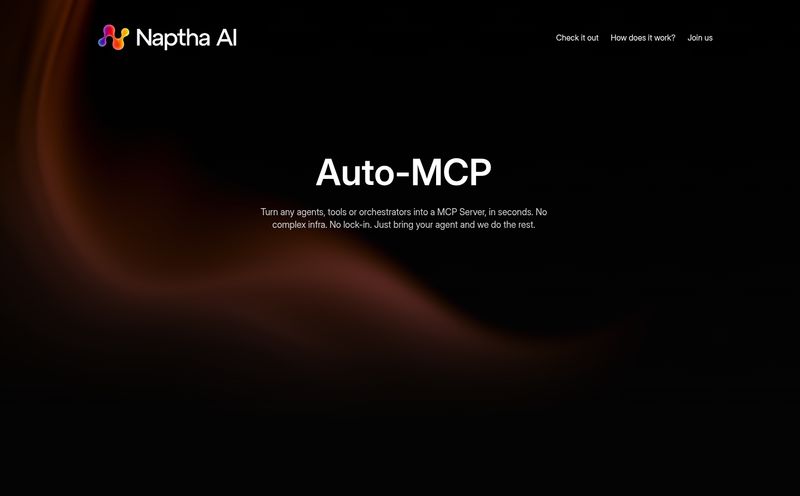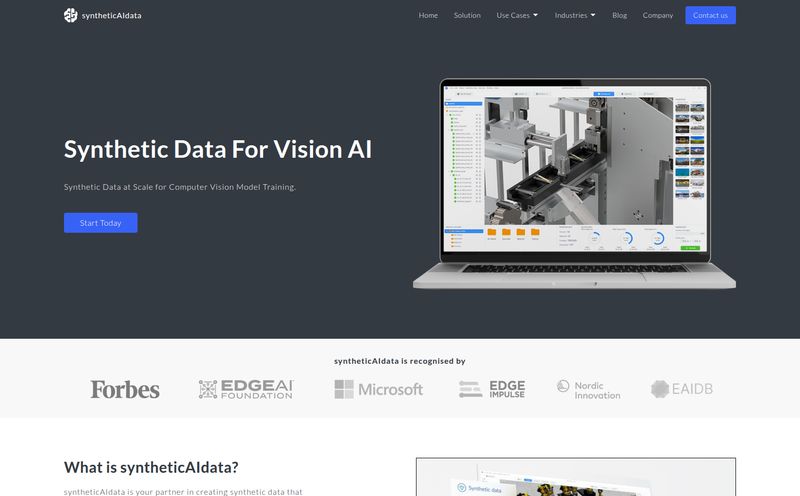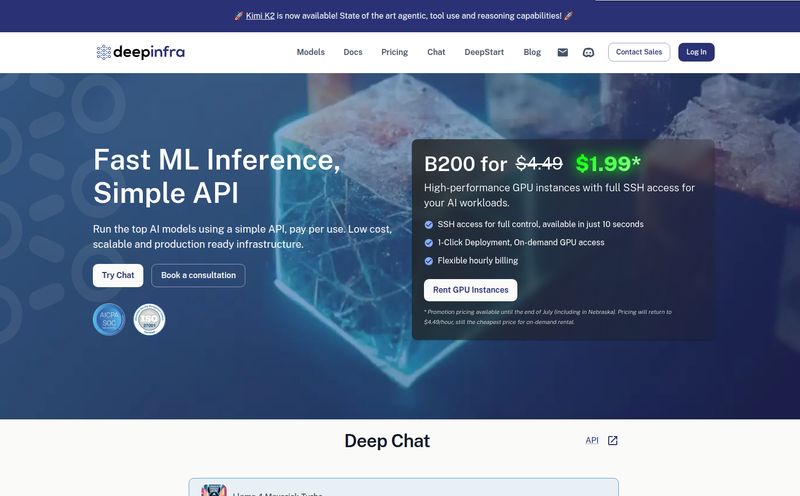If you've spent any time in the web development world, you know the drill. The designer hands over a pixel-perfect, absolutely gorgeous Figma file. It’s a work of art. And then you, the developer, have to sit there and painstakingly translate every single box, button, and gradient into actual, functional code. It’s a process that can feel... well, a bit like tracing a masterpiece by hand. Tedious. Time-consuming. And ripe for tiny, infuriating errors.
For years, we've been promised a magic bullet. A tool that could just look at a design and spit out perfect code. Most have been clunky, unreliable, and produced code that looked like spaghetti thrown at a wall. So when I heard about Niral.ai, a platform claiming to speed up front-end development by a whopping 70% using AI, my inner cynic raised an eyebrow. But my inner tech geek leaned in a little closer. Could this be the one?
I’ve spent some time kicking the tires and looking under the hood, and I'm here to give you the unvarnished truth about Niral.ai. Is it the real deal, or just another cog in the hype machine?
What Exactly is Niral.ai? (And Why Should You Care?)
At its heart, Niral.ai is an AI-powered platform designed to be the ultimate bridge between design and development. You feed it your Figma designs, and it generates production-ready front-end code in popular frameworks like Angular, Vue, React, and even React Native. Simple enough, right?
But here’s the twist, and honestly, the part that got my attention. Niral.ai uses a "human-in-the-loop" concept. This isn’t just some black-box AI making its best guess. It suggests there's a layer of human oversight, a quality check to ensure the code isn't just functional but clean and maintainable. In an industry flooded with purely automated solutions, this feels like a smart, grounding feature. It’s less like a robot replacing a chef and more like giving the chef an incredibly sharp set of knives and a perfectly prepped mise en place.
The Core Features That Make Niral.ai Tick
Okay, let's get into the nuts and bolts. What’s actually inside this thing? A few key features stand out and paint a picture of a tool built for serious workflows.
From Figma Blueprint to Functional Code
The main event, of course, is the Figma-to-code conversion. The idea is to maintain your design's integrity—the layout, the components, the responsiveness—and translate it directly into a codebase. It supports the frameworks that most of us are using day-to-day. This isn't about generating a simple HTML/CSS page; it's about creating structured components for modern JavaScript frameworks. That’s a pretty big promise.

Visit Niral.ai
The "Human-in-the-Loop" Safety Net
I want to circle back to this because I think it’s the most important differentiator. Pure AI can be amazing, but it can also be... weird. It can make odd choices that a human developer would spot in a second. By adding a human validation step, Niral.ai is essentially promising to catch those weird things before they get to you. It's a layer of quality assurance baked right into the process, aiming for code that feels human-written, not just machine-generated. This could be the secret sauce that makes it truly usable in a professional setting.
More Than Just Code: API Integration and GIT Sync
A static front-end is nice, but most modern applications are anything but static. Niral.ai seems to get this. The platform includes features for API integration, meaning you can hook up the generated front-end components to your actual data sources. Furthermore, it offers GIT synchronization. This is crucial. It means the tool can fit into an existing development workflow, pushing code to your repositories and working alongside your team, not against it.
Building with Blocks: Component Libraries
One of the biggest time-sinks in front-end development is building and re-building the same components. Niral.ai addresses this with component libraries. It helps you create a set of reusable, on-brand components that can be used across your project. This not only speeds things up but also ensures design consistency. No more slightly-different-shades-of-blue buttons on different pages.
Let's Talk Money: Niral.ai Pricing
Ah, pricing. The moment of truth. Now, I have to be upfront here, I found some slightly conflicting information, which suggests their plans might be evolving. My advice? Always check their official pricing page for the absolute latest numbers. That said, here’s a breakdown of what I found, which seems to be the most current structure.
| Plan | Price (USD/month) | Best For |
|---|---|---|
| Starter | $39 | Individuals and small businesses needing the core features. |
| Pro | $79 | Growing teams needing real-time analytics and more support. |
| Enterprise | $149 | Larger organizations needing custom integrations and advanced security. |
Disclaimer: This pricing is based on available data at the time of writing. Please visit the official Niral.ai pricing page for the most accurate and up-to-date information.
For my money, the pricing seems pretty reasonable if—and this is a big if—it delivers on its promise. If it can genuinely save a developer dozens of hours a month, that $39 or $79 fee pays for itself almost instantly. The value proposition is strong.
The Not-So-Shiny Bits: A Few Caveats
No tool is perfect, and it would be dishonest to pretend otherwise. Based on how these platforms work, there are a few things to keep in mind.
First, the old 'garbage in, garbage out' rule applies with a vengeance. The quality of your generated code will be directly proportional to how well-structured and clean your Figma design is. If your Figma file is a mess of unnamed layers and inconsistent groups, you can’t expect Niral.ai to magically clean it up for you. A disciplined design process is a prerequisite.
Second, you are tying your wagon to Figma. For many of us, that's no big deal—Figma is the industry standard for a reason. But if your team is built around Adobe XD or Sketch, you're out of luck for now. It’s a specialized tool for a specific workflow.
My Final Verdict: Is Niral.ai Worth the Hype?
So, what’s the final call? After digging in, I'm cautiously optimistic. I don’t see Niral.ai as a tool that will make front-end developers obsolete. Not by a long shot. Instead, I see it as a massive accelerator. A powerful co-pilot.
Think of it this way: it handles the boring, repetitive part of the job—the initial scaffolding, the component boilerplate, the CSS translation. This frees up developer time and brainpower to focus on the hard stuff: complex state management, API logic, performance optimization and perfecting the user experience. The human-in-the-loop feature is the key that elevates it from a neat toy to a potentially serious professional tool.
Who is it for? I’d say Niral.ai is a fantastic option for digital agencies, startups, and freelance developers who are deep in the Figma ecosystem and are looking to dramatically increase their output without sacrificing quality. If you're constantly on a deadline and the design-to-code bottleneck is a real pain point, this is absolutely worth investigating.
Frequently Asked Questions about Niral.ai
- What frameworks does Niral.ai support?
- Niral.ai currently supports the big players in the JavaScript world: Angular, Vue, React, and even React Native for mobile app development. This covers a huge portion of modern web and mobile projects.
- Do I still need a front-end developer if I use Niral.ai?
- Absolutely, yes. Think of Niral.ai as an assistant, not a replacement. It generates the initial code, but a skilled developer is still needed to implement complex logic, ensure accessibility, optimize for performance, and manage the overall architecture of the application.
- Is the code generated by Niral.ai really "production-ready"?
- It aims to be. The combination of AI and human validation gets it much closer than most tools. However, you should always treat it as a high-quality first draft. A developer should always review, test, and potentially refactor the code to fit the specific needs of the project. It gives you a 90% head start, not a 100% finished product.
- How does Niral.ai handle responsive design?
- Typically, tools like this translate Figma's auto-layout and constraint settings into responsive CSS, using things like Flexbox or Grid. To get the best results, your Figma design needs to be built with responsiveness in mind from the start.
- Can I own the code generated by Niral.ai?
- Yes. According to their feature list, you get full ownership of the generated code. This is a critical point, as it means you’re not locked into their platform. You can take the code and do whatever you want with it, which is exactly how it should be.
A Smarter Way to Build
Tools like Niral.ai represent the evolution of development, not the end of it. They're about automating the mundane so we can focus on the meaningful. It won’t solve all your problems, and it requires a good design process to work effectively. But as a way to bridge the chasm between design and code, and to give your team a serious speed boost? I'm impressed. It might just be the tool we’ve been waiting for, afterall.



